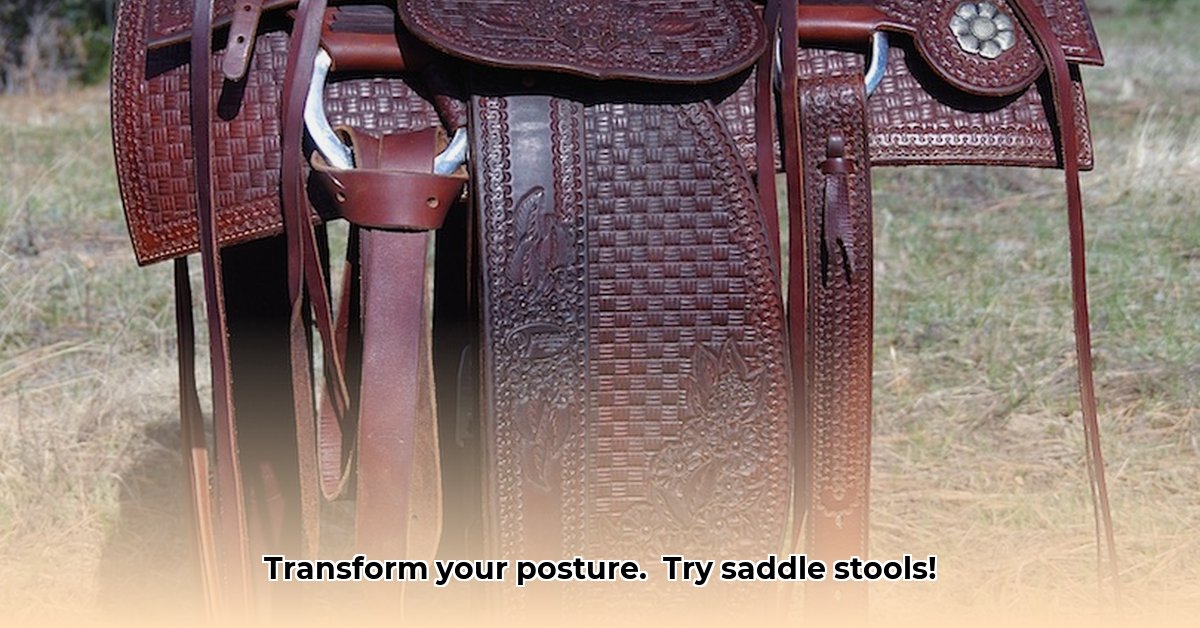Ditch the back pain and the slump! This guide is all about saddle stools – those unique seats that promise better posture and a more comfortable workday. We’ll explore if they really live up to the hype, help you pick the right one, and show you how to make the switch smoothly. We’ll even tackle the common worries about price and getting used to them. Get ready to learn everything you need to know to find the perfect saddle stool for you and say goodbye to that achy back!
Saddle Stools: Your Guide to Better Posture and Spinal Health
Let’s talk about saddle stools – those unique seats that look like something from a futuristic office, or maybe a fancy stable. They’re gaining popularity, and for good reason: many people find they improve posture and comfort. But are they right for you? Let’s dive in and discuss spinal health.
What are Saddle Stools?
Imagine a chair that encourages you to sit up straight, naturally. That’s essentially a saddle stool. Instead of slumping into a traditional chair, these stools promote a more open, upright posture, similar to sitting on a horse (though much more comfortable!). The design keeps your hips slightly open, supporting your spine in a way that reduces strain. You’ll find various types – some with a single, molded seat, others with a more divided, saddle-like design. Consider its unique seating options.
Ergonomic Benefits and Drawbacks of Saddle Stools
The main draw? Better posture! Saddle stools gently nudge your spine into a neutral alignment, which can be a real game-changer if you spend hours sitting. This helps avoid the slouch that often leads to backaches. Plus, engaging your core muscles helps with stability and might even improve circulation. Let’s see the ergonomic design.
However, switching to a saddle stool may cause initial discomfort as muscles adapt to the new posture. Many users report feeling a bit stiff or uncomfortable at first. This is perfectly normal; your body needs time to adjust to this different sitting position. It’s kind of like learning to ride a bike – a little wobbly at first, but eventually smooth sailing! Adaptation is key to finding the best ergonomic sitting position. Allow your body time to adjust and consider taking breaks to stretch.
Another factor to consider: price. Saddle stools tend to be pricier than your average office chair due to their specialized design and ergonomic features. While some anecdotal claims suggest they burn extra calories, rigorous scientific evidence for this is still lacking. So, don’t buy one expecting to lose weight! Don’t expect too much for the long term ergonomic advantages.
Before & After Posture:
(Imagine an image here showing poor posture in a regular chair, then excellent posture on a saddle stool)
Choosing the Right Saddle Stool
Finding your ideal saddle stool involves several key considerations: and chair adjustability.
-
Adjustability: Height is everything! A stool that’s too high will force you to hunch, while one that’s too low makes you slouch. Look for adjustable height and even tilt options for customized comfort. Fine-tuning the height can make a world of difference in optimizing your posture and comfort. Additionally, consider stools with adjustable seat angles to find the perfect hip and spine alignment.
-
Materials: Think about durability, comfort, and style. High-quality leather or sturdy, breathable fabric will last longer and provide a more pleasant seating experience. Consider your personal taste, budget, and any allergies you may have. Some materials may even offer better breathability during warmer months. A well-padded seat can also make a significant difference in comfort.
-
Intended Use: Your job and typical activities play a crucial role. A surgeon needs a different stool than a graphic designer. A taller stool is likely better for someone at a high workbench, while a shorter stool would suit a different task. Also, consider whether you need a stool with a backrest for added lumbar support.
Here’s a simplified comparison to help you visualize the options:
| Feature | Budget-Friendly | Mid-Range | High-End |
|---|---|---|---|
| Height Adjust. | Basic, limited range | Adjustable height | Extensive, precise adjustments |
| Material | Plastic, Vinyl | Metal, faux leather | Premium leather, wood, mesh |
| Features | Basic design | Enhanced comfort features | Advanced ergonomic features |
| Price Range | Under $100 | $100 – $300 | Over $300 |
Adapting to Your Saddle Stool
The transition is key to success! Start slowly. Begin with short sessions on your new stool, increasing the duration gradually. Pay attention to your posture, experimenting to find the most comfortable position. It’s a process; don’t expect to feel perfect from day one. Listen to your body, and consider the transition period. You may experience some muscle soreness initially, which is a sign that your body is adjusting.
Top Saddle Stool Brands and Models
While I won’t endorse any particular brand, plenty of reputable manufacturers focus on ergonomics and quality. Look for brands known for their ergonomic research and commitment to user comfort. Do your research! Read online reviews carefully, paying attention to what users say about long-term comfort and durability. Look for patterns in reviews to identify reliable options. Consider both professional reviews and customer testimonials to get a well-rounded perspective. Some things to consider are office ergonomics and office furniture.
Maintenance and Care
A little care goes a long way! Cleaning your saddle stool regularly will keep it looking good and functioning properly. Always follow the manufacturer’s instructions for cleaning, as different materials require different care. Regular dusting and occasional wiping are generally sufficient. For leather stools, consider using a leather conditioner to keep the material supple.
Frequently Asked Questions (FAQ)
- Are saddle stools worth the cost? Many users believe the long-term ergonomic advantages and potential relief from back pain justify the price. However, this is subjective and depends heavily on individual needs and experiences. Consider it an investment in your health and productivity if you spend significant time sitting.
- Will I be uncomfortable at first? Yes, some initial discomfort is normal. Remember to ease into it gradually.
- Do saddle stools really help with back pain? They can help by promoting better posture and engaging core muscles, which can alleviate pressure on the spine. However, this isn’t a guaranteed cure-all. Individual results vary, and consulting a healthcare professional is always a good idea, particularly if you have pre-existing back problems. Prioritize your long-term well-being.
Investing in better posture is an investment in your comfort and long-term well-being. By considering these factors and taking a measured approach, you’ll be well on your way to finding the perfect saddle stool to enhance your health and productivity. Remember that ongoing research continues to explore the long-term effects of saddle stools, offering potential for even better designs and understanding in the future. Stay informed about the latest developments in ergonomic seating to make the best choice for your needs.
How to Choose the Best Ergonomic Saddle Chair for My Body Type
Key Takeaways:
- Saddle chairs offer posture improvement and core engagement but might initially feel uncomfortable and come with a higher price tag.
- Proper chair selection hinges on adjustability, materials, and intended use. Your body type is key.
- A gradual adjustment period is needed for optimal comfort and postural adaptation.
- Choosing the right saddle chair involves careful consideration of various factors for long-term comfort and effectiveness.
What are Saddle Stools?
Saddle stools are unique seating options designed to promote active sitting. Unlike traditional chairs, they encourage an upright posture, engaging your core muscles and improving your posture. They come in various styles, with or without backrests, and in different materials. Consider this unique seating option.
Ergonomic Benefits and Drawbacks
Active sitting, encouraged by saddle stools, can reduce back strain and improve circulation. However, switching to a saddle stool may cause initial discomfort. Before-and-after pictures readily illustrate this posture shift. The purported calorie-burning benefits lack rigorous scientific support. Let’s be realistic; it’s not a weight-loss miracle! Let’s discuss the ergonomic design benefits.
Choosing the Right Saddle Stool: A Step-by-Step Guide
How to choose the best ergonomic saddle chair for my body type is a multi-step process. Here’s exactly how you do it: Prioritize chair selection.
-
Assess Your Needs: How long will you sit? What tasks will you perform? Do you have pre-existing back problems? Answering these questions helps you define your requirements. For example, someone with lower back pain might need a stool with a backrest and adjustable lumbar support, while a dentist needs a stool that allows them to lean in close to their work while maintaining good posture.
-
Prioritize Adjustability: Height adjustability is crucial. Find a stool that allows for proper knee and hip positioning. A too-high or too-low stool negates the ergonomic benefits. Look for stools with a pneumatic lift for easy height adjustment. Ideally, your thighs should be slightly angled downward when sitting on the stool.
-
Consider the Materials: Leather, vinyl, and mesh offer varying comfort levels and breathability. Leather is luxurious but may be less breathable. Mesh is cool but potentially less durable. Consider the climate you
- White On White Kitchen Backsplash: Is It Timeless? - November 20, 2025
- Backsplash Colors for White Cabinets: Find Your Perfect Match - November 19, 2025
- Backsplash Ideas for White Cabinets: Find Your Perfect Style - November 18, 2025










